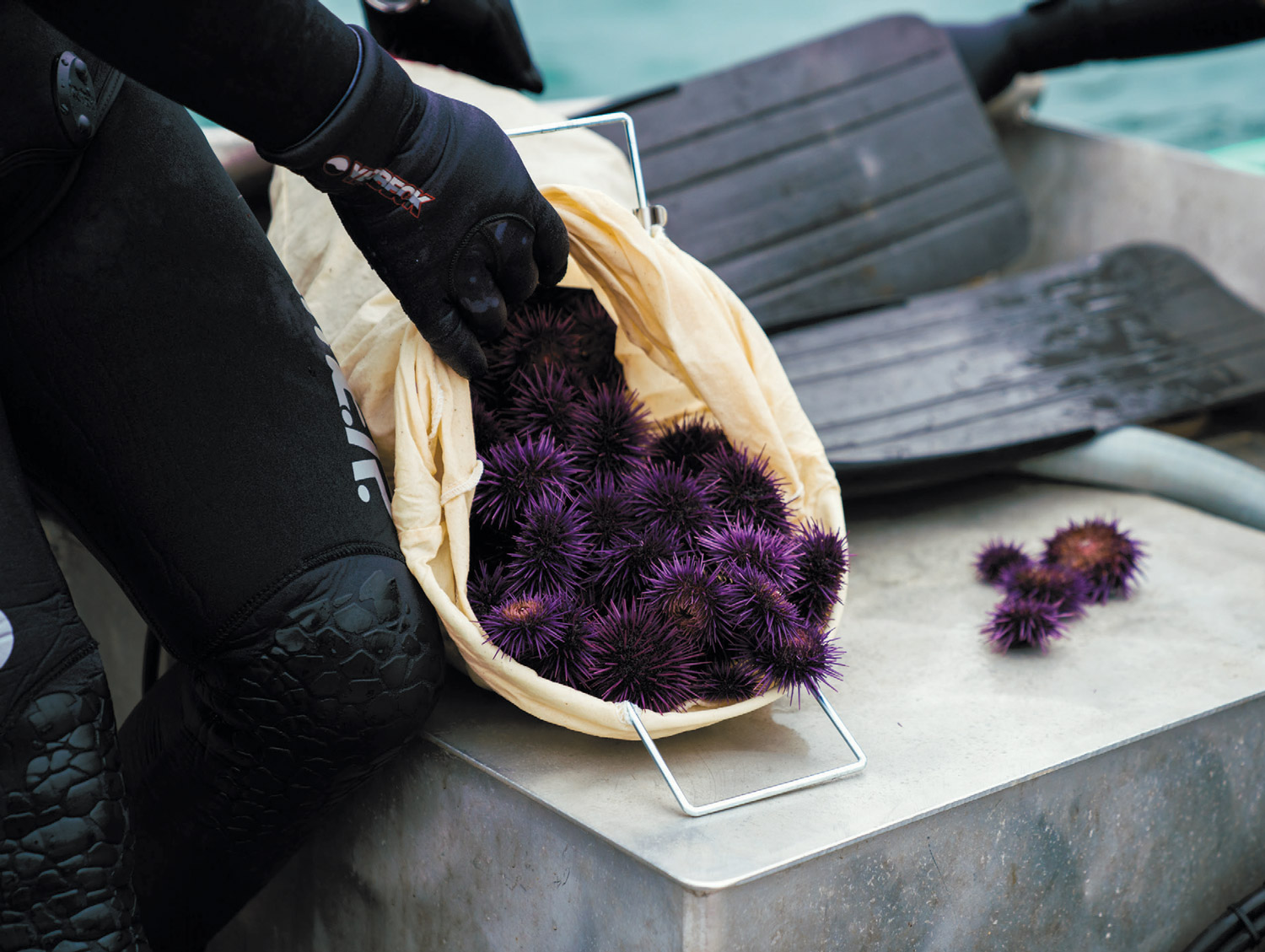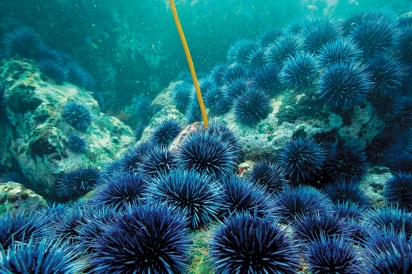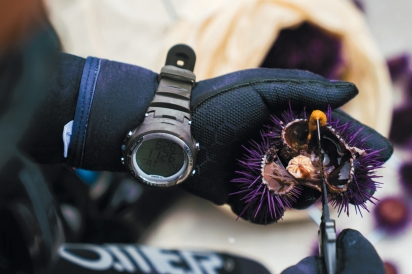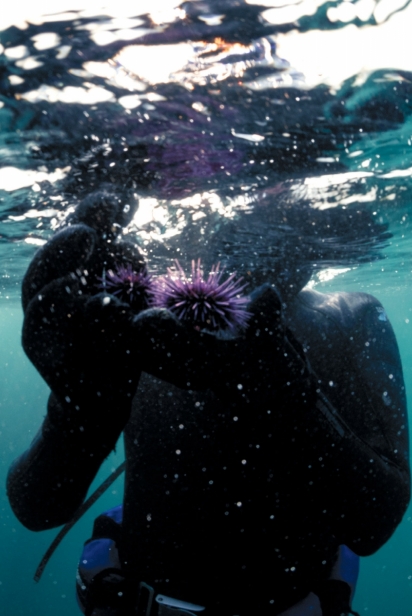Urchin Explosion
THE UNDERWATER BATTLE BEING WAGED ALONG OUR COAST
My first attempt to free dive for red abalone was with a group of Santa Cruz–based surfers who took to the water like sea otters—popping underwater to come seemingly right back up holding a magnificent sea snail, then popping back down for another. After a while of watching from the Point Arena Pier in Mendocino, I finally worked up the courage to join them. Making my way through the churning Pacific, it felt like being caught in a washing machine. And then there were the frequent stops needed to disentangle myself from long strands of kelp.
As soon as I reached the guys, one passed me his weight belt—he had already bagged the daily limit of three. Another coached me, “Dive down about 12 feet, and there’s a big one under the rock.” I checked to make sure my mesh collecting bag and small metal bar for prying the abalone off the rock were ready, but inwardly I was thinking, “You’ve got to be kidding.”
I made it down to the designated rock, a feat in and of itself, but didn’t see the abalone through the murk, let alone take it by surprise and insert the bar between it and its rocky home. I made a few more attempts, each time drifting farther away from the rock, acutely wary of being entangled and trapped by kelp—and drowning.
I would not have been the first abalone casualty. Already that season, only seven months long, nine people had died in Northern California while diving for abalone. The specific causes of death varied—some did fall victim to kelp ensnarement and drowned, others were caught in rip tides and dragged out to sea, some were trapped in underwater caves by pounding waves. Over the years, people have fallen off cliff s while scouting a new abalone spot, and others have had strokes and heart attacks far from cell service, much less medical care. And, on occasion there have been Great White bites. Despite these dangers, thousands have continued to seek out this iconic delicacy each abalone season.
Empty handed, I began to make my way back to shore, choosing a calmer route close to the pier. There, I discovered an underwater field of purple sea urchins. It was a little eerie, as nothing else appeared to be living there, but these were low-hanging fruit compared to the abalone. I plucked the biggest ones and put them into my bag. Truth be told, I prefer eating the urchins’ creamy roe, or uni, to abalone anyway.
Back at our rental house, while the guys cleaned and tenderized the abalone for our dinner, I opened the urchins and removed their custardy gold roe sacs. Smaller than the red urchins that are harvested commercially and commonly offered in Japanese restaurants, the purple urchins still offered exquisite roe. The brightest-colored, firmest roe we ate right out of the shell. It was both sweet and briny, and tasted of flowing kelp and deep upwells and everything magical about our coast.
The less pristine roe we blended into a buerre blanc sauce, destined to be paired with a bit of bacon and arugula in an uni carbonara. What uni we had left was mixed with unsalted butter (a ratio of 40% uni to 60% butter) and frozen in small containers. These little flavor packets are fantastic to have on hand for tossing on soba noodles for a quick and delicious meal.
The uni feast went a long way toward assuaging my disappointment at not getting an abalone that day, but I was already plotting my next attempt.
ABALONE VERSUS URCHIN
While abalone had been showing signs of decline for some years prior, mass mortalities of the sea snails started in 2017. With no improvement in sight, the California Fish and Game Commission, having determined that the population was too reduced and vulnerable to allow even limited recreational harvesting, canceled the 2018 season entirely, and announced that it would remain closed until at least 2021.
While the indefinite closure is a major disappointment to those who ritually dive for and eat abalone, and a significant economic blow to the coastal businesses that thrive on the outfitting, housing and feeding of these recreational divers, the real crisis is the one that is taking place underwater.
In the simplest of terms, the problem is that abalone eat kelp, and the kelp along our coast is largely gone. In fact, scientists estimate that bull kelp forests are down 90% since 2014.
Bull kelp is an annual alga species. Under normal conditions, they release their spores in late summer and fall—prior to the arrival of winter storm waves that rip out much of the mature kelp. The spores grow rapidly in the nutrient-rich, cold waters along the Northern California coast, forming kelp forests that shelter and feed a whole host of other marine life.
“Kelp forests provide habitat and food sources for many animals,” Cynthia Catton, PhD, an environmental scientist with the California Department of Fish and Wildlife (CDFW) currently conducting research on the crisis from the UC Davis–Bodega Bay Marine Lab, said during our interview. “As well, they filter out sunlight coming through their blades and are responsible for massive photosynthesis and respiration in the water. Not having them drastically impacts ocean ecosystems.”
She went on to explain that when the ocean is in balance and food is abundant, abalone and sea urchin, which both feed on the kelp, can co-exist happily. In fact, urchin can actually benefit abalone— urchin typically live in the crevices in and between underwater rocks, and baby abalone shelter beneath them, protected from predators by the urchin’s spines. And when urchins transfer food to their mouths, located on their undersides, the baby abalone are also fed.
When there’s not sufficient food, however, urchins adapt. “Urchins are able to adjust their behavior and increase the size of their jaw and teeth, and have access to more food,” Catton said. “They come out of crevices and form ‘feeding fronts.’ These are urchin barren conditions.” This explained what I had seen in Point Arena; and leaves baby abalone without their shelter, as well as an important source of food.
While adaptive, “urchin barren” behavior is not sufficient, even for the urchins themselves. Catton explained that while red and purple urchin numbers have not declined as precipitously as the abalone, they are starving. Red urchins are now largely empty of roe, their means of reproduction, so their numbers are dropping significantly. Purple urchins have much less roe, as well, but apparently enough to reproduce—hence their takeover.
According to Catton, the kelp decimation is due to a “perfect storm” of environmental stressors that have triggered shifts in the entire ecosystem. In 2011, there was a toxic algal bloom along the Sonoma coast that killed off many invertebrates that live in shallow waters, including huge numbers of abalone along with sea stars, and even urchins. This set the stage for the 2013 outbreak of “Sea Star Wasting Disease,” which impacted the West Coast from Baja to Alaska. Kelp forest dwellers that feed on sea urchin, the sea star die-off resulted in an explosive growth of urchins. Next, a marine heat wave or “warm blog” hit in 2014, then the strong El Niño of 2015 ushered in warmer waters, which have fewer nutrients than cold upwellings normal for Coastal California—and are required for kelp growth.
CAN NATURE HEAL ITSELF?
Even if the waters cool, the kelp may not come back. Catton’s research is showing that the urchins are blanketing rocks that are normally covered with an algal crust. “These are essentially photosynthetic rock,” she explained. “It’s really hard to eat, yet now 70–80% of the rock is exposed because that crust has been so aggressively grazed [by the urchin]. If that’s being grazed, then the kelp spores [on the rocks] are also being grazed.”
Another natural predator of sea urchins, the sea otter, was killed off by fur trappers along Northern California a century ago.
EFFORTS BEYOND MOTHER NATURE
Ocean lovers—and, specifically, abalone, lovers—are not just going down without a fight. A coalition known by the acronym KELPRR, which stands for the Kelp Ecosystem and Landscape Partnership for Research on Resilience, and spearheaded by CDFW, is bringing the community together to work toward both short and long-term solutions.
One measure that can show immediate, if not dramatic, results are sea urchin culls in targeted areas along the coast. These culls, organized by KELPRR member the Watermen’s Alliance, a nonprofit that advocates for diver rights in regards to abalone and spear fishing, in coordination with other KELPRR partners including CDFW, the Noyo Center for Marine Science, Reef Check California, the Greater Farallones National Marine Sanctuary and others, have removed an estimated 200,000 purple urchins since the first harvest on Memorial Day 2018.
I caught up with Josh Russo, president of the Watermen’s Alliance, at Van Damme State Park just south of the town of Mendocino, this past winter. Winds from the south were blowing up waves that crashed against the rocky coastline with operatic drama. Cars full of hopeful divers kept pulling into the parking lot, but Russo had called off that day’s planned urchin harvest due to the rough seas. “I have no idea what everyone’s diving level is,” he said. “I can’t be responsible.” These culls are open to recreational, as well as professional, divers.
A passionate abalone diver himself, Russo is also a guide and instructor. I told him about my first failed attempt. “Look, ab diving can be hard and dangerous if you just head out there not knowing what you’re doing. But if you have a good teacher, it can be safe and fun” he consoled. He pointed out into the Pacific—“That’s where I taught your editor, Gibson [Thomas], how to dive for abalone. She caught her limit.” When I asked Thomas about that experience, she said she credits Russo’s reassuring and calm demeanor with her success on what was her first, and now maybe her only, abalone hunt.
The idea is to conduct the culls in areas that already show signs of kelp re-growth. “As soon as the kelp starts to grow back, the urchins dogpile on and decimate it. So we are trying to give the kelp a chance. We are also working to find a commercial use for the urchin,” Russo told me. “If it’s profitable to get them out, people will get them out.” That would certainly attract more professional divers to the effort.
Also affected by this crisis are commercial uni divers who make their living harvesting the more culinarily desirable red uni off shore. Less opportunistic than their purple brethren, these red uni are also starving and unable to reproduce in viable numbers. The fishery has collapsed and the divers have collectively filed for disaster relief with the federal government.
According to Sheila Semans, executive director of The Noyo Center for Marine Science in Fort Bragg, Noyo has been engaging these recently “underemployed” commercial divers to help with the purple urchin crisis. Equipped to stay down for four to five hours at a time, these divers are far more effective than recreational divers at removing the purple urchins—in fact, they took an estimated 1.2 million purple urchin out of the water last year. “Still, this was a drop in the bucket,” Semans said.
MONETIZING THE PURPLE URCHIN
Urchin barrens are a problem in many areas of the world where natural predators have been overfished, or climate change has altered the ecosystem, not just the Northern California Coast, so the KELPRR coalition is also looking beyond our area for solutions, and partners.
One partner that joined other local efforts last year is Urchinomics, a Norway-based company that already had a presence in Canada and Japan, that has developed a system for fattening up the wild-harvested purple pincushions in onshore facilities before selling them to eager buyers in Asia.
Noyo’s Semans explained, “Urchinomics needs a facility in Northern California, and Fort Bragg is ground zero. This could help us keep uni fishermen employed, create a revenue stream to fund restoration, and our local chefs are onboard and ready to start making dishes with purple urchins.”
WHAT WE CAN DO
Some initiatives, like Urchinomics’ development of a commercial market for the purple urchin, are part of a long-term solution, but CDFW’s Catton admits that many of these efforts are merely emergency stop-gap measures until the kelp forests come back. If they come back.
When I asked if there was a possible silver lining in this crisis, she said there are a few. “We are no longer thinking abstractly about climate change. We are seeing it,” she said. “It’s teaching us how interconnected all our systems really are. And we are having very different groups come together to try and remedy it. Commercial fishermen and environmentalists, underwater sport hunters and chefs and breweries and surfing nonprofits.”
It’s going to take a diverse ecosystem of concerned citizens, nonprofits, commercial fishermen/divers and governmental agencies to save our rich underwater ecosystem. Here are a few ways you can get involved:
Visit the Noyo Center’s website, NoyoCenter.org, and click on “Help the Kelp” for more information and resources.
Experienced divers can take part in a sea urchin cull—visit the Watermen’s Alliance Facebook page to learn when and where: Facebook.com/groups/158992911481142/
Train as a “citizen scientist” diver through Reef Check. ReefCheck.org.
Ask your favorite chef to source uni from locally harvested purple urchins! It’s coming soon to a table near you.
FIND OUT MORE!
Photographer and cinematographer Sashwa Burrous, a Sonoma County native, is working with other collaborators to produce the documentary Finding Forests, which will tell the story of the Northern Coast of California, the crash of the kelp and abalone populations and the story of a woman’s journey to protect the coast she loves. Learn more at FindingForestsFilm.org.










